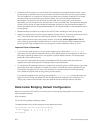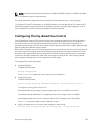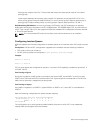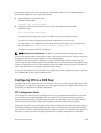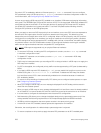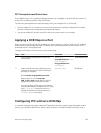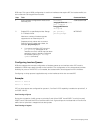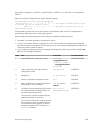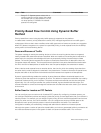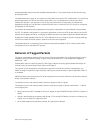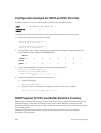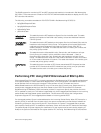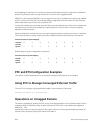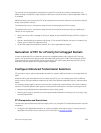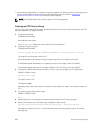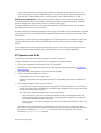
Step Task Command Command Mode
Range: 0-3. Separate queue values with a
comma; specify a priority range with a dash;
for example: pfc no-drop queues 1,3 or pfc
no-drop queues 2-3 Default: No lossless
queues are configured.
Priority-Based Flow Control Using Dynamic Buffer
Method
Priority-based flow control using dynamic buffer spaces is supported on the platform.
In a data center network, priority-based flow control (PFC) manages large bursts of one traffic type in
multiprotocol links so that it does not affect other traffic types and no frames are lost due to congestion.
When PFC detects congestion on a queue for a specified priority, it sends a pause frame for the 802.1p
priority traffic to the transmitting device.
Pause and Resume of Traffic
The pause message is used by the sending device to inform the receiving device about a congested,
heavily-loaded traffic state that has been identified. When the interface of a sending device transmits a
pause frame, the recipient acknowledges this frame by temporarily halting the transmission of data
packets. The sending device requests the recipient to restart the transmission of data traffic when the
congestion eases and reduces. The time period that is specified in the pause frame defines the duration
for which the flow of data packets is halted. When the time period elapses, the transmission restarts.
When a device sends a pause frame to another device, the time for which the sending of packets from
the other device must be stopped is contained in the pause frame. The device that sent the pause frame
empties the buffer to be less than the threshold value and restarts the acceptance of data packets.
Dynamic ingress buffering enables the sending of pause frames at different thresholds based on the
number of ports that experience congestion at a time. This behavior impacts the total buffer size used by
a particular lossless priority on an interface. The pause and resume thresholds can also be configured
dynamically. You can configure a buffer size, pause threshold, ingress shared threshold weight, and
resume threshold to control and manage the total amount of buffers that are to be used in your network
environment.
Buffer Sizes for Lossless or PFC Packets
You can configure up to a maximum of 4 lossless (PFC) queues. By configuring 4 lossless queues, you
can configure 4 different priorities and assign a particular priority to each application that your network is
used to process. For example, you can assign a higher priority for time-sensitive applications and a lower
priority for other services, such as file transfers. You can configure the amount of buffer space to be
allocated for each priority and the pause or resume thresholds for the buffer. This method of
configuration enables you to effectively manage and administer the behavior of lossless queues.
Although the system contains of space for shared buffers, a minimum guaranteed buffer is provided to all
the internal and external ports in the system for both unicast and multicast traffic. This minimum
260
Data Center Bridging (DCB)



